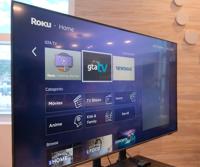GTA unveiled its new television streaming platform, GTA TV, at an event called “Stream BIG” held on Thursday at the GTA Experience Center in Tamuning, but the announcement signals a much larger investment in the island’s telecommunications infrastructure.
The new TV service allows customers to stream more than 150 channels in high definition across multiple devices, including televisions, smartphones, tablets and streaming devices such as Apple TV, Amazon Fire Stick and Roku. Behind this visible consumer offering, however, lies an ambitious multiyear plan to transform Guam’s connectivity landscape.
“We are transforming ourselves. Coming from a copper-based company to a fiber-based company. Again, to meet the demands,” Andrew Gayle, GTA’s chief operating officer and company veteran since 2005, told members of the local media and others attending the event.
Gayle told The Guam Daily Post they are investing “hundreds of millions of dollars” to expand their fiber network across Guam as part of a comprehensive approach to meet the island’s increasing telecommunications needs.
Fiber expansion
The aggressive fiber expansion plans will reach approximately 80% of Guam in three years, with the remainder expected to be covered within five years, according to Gayle.
“We are fully, fully bullish on meeting the telecommunications requirements of Guam and all of our customers. Whether they’re consumers, regular residential customers or business customers,” he said.
The company is expanding its fiber network village by village, with current deployment in Tamuning, Yigo and Dededo. The southern portion of Guam will receive fiber coverage through a USDA grant.
“South is 100% covered by the USDA grant. So, we’ll do 100% of the south from Yona all the way down through to Agat, Santa Rita and then across. That will be done, hopefully get done by 2027, 2028,” Gayle said.
Nathan Denight, GTA’s vice president of marketing and product, told the Post they’re also connecting large multi-dwelling units: “We’re also doing some like large MDUs, like condos or big business buildings. So, we did like Summer Towers, Oka Towers.”
Changing viewing habits
Gayle highlighted how changing consumer habits are driving the need for enhanced connectivity solutions.
“Traditional TV watching has changed. It has definitely changed from the sit back and scroll, and I will watch what you’re showing to me versus the demand, ‘Hey, I want to watch this particular time and this particular location,’” Gayle said.
Denight echoed this sentiment: “Customers want to access their content where they’re at. It’s not just sit in the living room and watch on the big screen with the family anymore. People are on the go, on their device, they’re on their tablets, their smartphones.”
These changing habits, coupled with increased adoption of artificial intelligence and video consumption, are driving GTA’s network expansion strategy.
Post-Mawar adjustments
In the aftermath of Typhoon Mawar in 2023, GTA reevaluated its approach to network deployment, prioritizing storm resilience.
“After Typhoon Mawar, we re-evaluated that. And we changed the way we deployed our network,” Gayle said. “Our goal is to place as much fiber underground as possible, all the way into the neighborhood and only at the very last second, maybe pop up on a pole and then over to the house.”
This shift means deployment will take longer and cost more, but the company believes it’s a necessary investment for future resilience. Gayle noted that Typhoon Mawar was the first major storm since Typhoon Pongsona in 2002.
“Typhoon Mawar reminded us that Guam is susceptible to these events, and we need to adjust the way we build out our network to account for that. And we have,” Gayle said.
Air Fiber
While the fiber rollout continues, GTA has introduced “Air Fiber,” a fixed wireless solution providing up to 500 megabits per second of download speed. It officially launched in January after testing in late 2024.
“With Air Fiber, we have placed a small antenna on your home, a powered antenna and we can beam a direct broadband connection to your home. It’s not using our mobile wireless mobility network. It’s a specific network just for wireless home internet to your home,” Denight said.
The company currently covers approximately 50% of the island’s population with Air Fiber service. Upload speeds, while advertised at 20 megabits per second, have reached as high as 70 megabits per second for some customers.
“Hard line, direct fiber connection all the way to your home or business is the best connection you can get for download and upload. And it’s also future-proof where you can change the electronics on the other side of the fiber and get even faster speeds. But I think our second best option is this fixed wireless access technology,” Denight added.
Local cloud
The new GTA TV service relies on local cloud infrastructure, which the company has invested in to support features like cloud DVR functionality. This allows customers to record and access content from various devices while maintaining service reliability.
“We’ve decided that even though, yeah, we could have hosted this on a cloud, we could have gone onto Amazon Web Services and done it that way, we decided to do that here for latency purposes, for resiliency purposes, for control purposes, for experience purposes,” Gayle said.
These facilities feature concrete buildings without windows, dual generators, redundant air conditioning systems and battery backups - all designed with resilience against Guam’s occasional severe weather events.
Ownership stability
Huntsman Family Investments, GTA’s current owner, has maintained ownership for nearly eight years - longer than any previous owner since the company’s privatization.
“They are very bullish on Guam, very bullish on the area. Like I said, we’re continuing to invest in the island, and they are continuing to invest in the island,” Gayle said. “And there’s no plans for them to change that at any particular time.”
The stable ownership has helped GTA pursue its long-term infrastructure vision, including the new cable landing station that will connect to submarine cables like Bifrost, enhancing connectivity not just for Guam but for the broader region.
Competitive positioning
Denight emphasized GTA’s competitive position in fiber deployment, stating, “We have the most fiber coverage of anyone on island right now, and we’re expanding faster than anyone.”
If the BEAD (Broadband Equity, Access and Deployment) federally funded program becomes available, GTA plans to participate, potentially accelerating the fiber deployment timeline beyond the company’s self-funded plans.
“Our goal is regardless if that funding ends up becoming available and there’s a process that’s going on right now, we’ll definitely participate and try to get that funding to enhance or accelerate the fiber delivery to all the residents on the island,” Gayle said.












